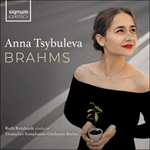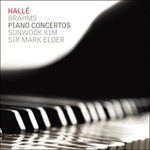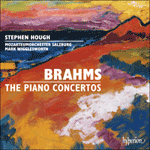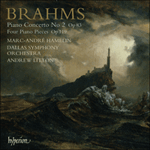
Welcome to Hyperion Records, an independent British classical label devoted to presenting high-quality recordings of music of all styles and from all periods from the twelfth century to the twenty-first.
Hyperion offers both CDs, and downloads in a number of formats. The site is also available in several languages.
Please use the dropdown buttons to set your preferred options, or use the checkbox to accept the defaults.

Thus Brahms seems to meld the principles of concerto and symphony—especially in the spacious first movement, Allegro non troppo, which grows organically into a grand tonal network of interconnected ideas. The piano does not merely repeat the themes of the orchestral tutti but engages in a wide-ranging dialogue by continually varying them. Despite the generally optimistic tone, darkness and passion have their places—the former represented by sudden glimpses of distant tonal areas, the latter by the more choleric of the piano’s monologues. After this the D minor scherzo, Allegro appassionato, hints at real tragedy. Its first subject has an impetuous zeal, while the second is a haunting tune full of submissive pathos. An angry development then leads to the trio section’s grand, Handelian D major theme before the scherzo music returns, urgent and volatile to the last.
The spirit of chamber music is most marked in the Andante slow movement, which is framed by a deeply expressive cello solo, a kind of sublime lullaby which many have seen as an anticipation of the song Immer leiser wird mein Schlummer (‘My sleep grows ever quieter’) that Brahms was to compose in 1886. The piano never has this tune, but muses upon its harmonic background in filigree passagework and decoration of the utmost plasticity. The overall impression is of self-communing improvisation, where motivic development dissolves into the stream of consciousness. There is a central episode, dominated by reflective piano arpeggios and clarinets in thirds, that might seem an exercise in pure sonority. Yet what the clarinets play is an exact quotation from Brahms’s song Todessehnen (‘Yearning for death’), composed three years earlier but not published until 1882 (as Op 86 No 6)—an unusual self-quotation for this composer, confirming the deep personal significance of the movement.
The finale, Allegretto grazioso, releases the accumulated tensions in a playful rondo, strewing tunes around (many in Brahms’s beloved Hungarian rhythms) like unconsidered pearls. This is a complex fusion of rondo and sonata form that wears its intricacy with insouciance. The piano summons up lilting, instantly memorable, themes in seemingly artless profusion. Yet there is immense artfulness here: not only in the many subtle rhythmic contrasts, but also in the ‘gypsy’ languor of the second-subject tune, in the Mozartian wit of the epigrams bandied about between soloist and orchestra, and in the easy confidence of scoring that allows Brahms to write grand, full-hearted tuttis without once requiring trumpets or drums.
It may not be implausible to hear this concerto as a kind of pianistic autobiography—by a composer for whom the piano, and piano music, lay at the centre of his creativity. The first movement’s quality of carefully structured improvisation plausibly presents a portrait of the young virtuoso, responding to the voice of Nature (the horn theme) with a hugely confident display of pianistic technique. But the scherzo intervenes, in D minor—for Brahms a key of catastrophic associations (the First Piano Concerto, begun in the aftermath of Schumann’s suicide attempt and incarceration in an asylum, makes this clear). However the robust and enlivening ‘Handelian’ trio perhaps represents the saving grace of study, the power of the music of the past to strengthen and stabilize the composer—as Brahms’s Baroque studies had strengthened him, issuing at length in his Op 24 Handel Variations.
The slow movement would then indicate a period of withdrawal, of self-communing at the keyboard, almost of self-effacement. In Brahms’s own solo output this mood is most clearly felt in the long series of late pieces which had begun during the 1870s with his Op 76 Klavierstücke. The wonderful main theme, however, is entrusted to the solo cello: the piano muses round it, decorates it, dialogues with the cello as a subordinate partner. The extent to which this movement resembles a cello–piano duet suggests (quite apart from the tenderness of the main idea) some imaginative link with Clara Schumann. Perhaps Brahms was thinking of the Romanze slow movement of her own youthful Piano Concerto of 1835, which is even more of a cello–piano duo. The song-quotation, too, is probably connected with his feelings for her, especially where the text (by Max von Schenkendorf) speaks of ‘the secret heavy burden’ on the poet’s soul, which can only be lifted by union with ‘the sisterly being’ of the beloved. The main tune’s anticipation of Immer leiser wird mein Schlummer then fits into a potentially tragic context, for they are both songs about death, or the yearning for it. But the finale, with its Hungarian rhythms, its relaxed evocation of dance and song, counterbalances this by releasing an entirely different aspect of Brahms’s pianism: his sizeable output of music for enjoyment and relaxation, most notably the Hungarian Dances and Liebeslieder-Walzer. This finale remains of the highest artistic quality (and is no relaxation for the pianist); but the popular elements blent in it are essential to any rounded portrait of its composer.
from notes by Calum MacDonald © 2006
Brahms semble ainsi fondre les principes du concerto et de la symphonie, surtout dans le spacieux premier mouvement, Allegro non troppo, qui se développe organiquement en un immense réseau tonal d’idées interconnectées. Le piano ne se contente pas de reprendre les thèmes du tutti orchestral: il les varie constamment dans un ample dialogue. Le climat est globalement optimiste, mais la noirceur et la passion ne sont pas absentes, respectivement incarnées par de soudains aperçus de lointaines zones tonales et par le plus colérique des monologues pianistiques. Après quoi le scherzo en ré mineur, Allegro appassionato, insinue une véritable tragédie. Son premier sujet recèle une ardeur impétueuse, tandis que le second est un air entêtant, gorgé de pathos soumis. Puis un développement coléreux mène au grandiose thème haendelien en ré majeur de la section en trio avant le retour de la musique du scherzo, insistante et inconstante jusqu’à la fin.
L’esprit de la musique de chambre transparaît surtout dans le mouvement lent Andante, encadré par un solo de violoncelle profondément expressif, sorte de berceuse sublime en laquelle beaucoup ont vu une anticipation du lied Immer leiser wird mein Schlummer («Toujours plus léger devient mon sommeil») que Brahms devait composer en 1886. Le piano ne joue jamais cette mélodie, mais s’attarde sur son fond harmonique avec des passages en filigrane et une ornementation des plus plastiques. L’impression générale est celle d’une improvisation en autocommunion, où le développement motivique se dissout dans le flot de la conscience. L’épisode central, marqué par des arpèges pianistiques pensifs et par des clarinettes en tierces, peut s’apparenter à un exercice de pure sonorité. Pourtant, ces clarinettes citent exactement le lied brahmsien Todessehnen («Aspiration à la mort»), composé trois ans auparavant mais publié seulement en 1882 (op. 86 no 6)—une autocitation inhabituelle chez Brahms, mais qui confirme bien la profonde signification personnelle de ce mouvement.
Le finale, Allegretto grazioso, relâche les tensions accumulées en un joyeux rondo, éparpillant les airs (dont beaucoup sont dans les rythmes hongrois si chers au compositeur) comme des perles sans valeur. Voilà une fusion du rondo et de la forme sonate qui arbore sa complexité avec insouciance. Le piano fait appel à des thèmes chantants, immédiatement mémorisables, dans une profusion apparemment naturelle. Ce qui n’exclut pas une immense habileté, non seulement dans les nombreux et subtils contrastes rythmiques, mais dans la langueur «gitane» de la mélodie du deuxième sujet, dans l’intelligence mozartienne des épigrammes échangées entre le soliste et l’orchestre, et dans cette assurance aisée de l’écriture qui permet à Brahms de composer de grandioses et sincères tuttis sans jamais en appeler aux trompettes ni aux tambours.
Ce concerto peut être entendu comme une sorte d’autobiographie pianistique d’un compositeur dont le cœur de la créativité est occupé par le piano, et par la musique de piano. L’improvisation soigneusement structurée du premier mouvement nous offre un portrait du jeune virtuose répondant à la voix de la Nature (le thème du cor) par une démonstration, immensément assurée, de technique pianistique. Mais le scherzo survient, en ré mineur—chez Brahms, une tonalité d’associations catastrophiques (comme l’illustre le Concerto pour piano no 1, commencé après la tentative de suicide de Schumann et son internement dans un asile d’aliénés). Toutefois, l’énergique et animé trio «haendelien» incarne peut-être la grâce salvatrice de l’étude, le pouvoir qu’a la musique du passé de renforcer et de stabiliser le compositeur—comme les études baroques, finalement publiées dans ses Handel Variations op. 24, l’avaient affermi.
Le mouvement lent traduirait donc une période de retrait, d’autocommunion au clavier, presque d’effacement de soi. Plus qu’ailleurs dans l’œuvre solo de Brahms, ce climat est clairement perceptible dans la longue série de pièces tardives inaugurée dans les années 1870 avec les Klavierstücke, op. 76. Le merveilleux thème principal est confié au violoncelle solo: le piano, lui, rêvasse autour de ce thème, l’orne, dialogue avec le violoncelle comme un partenaire subalterne. La ressemblance de ce mouvement avec un duo violoncelle–piano suggère (outre la tendresse du thème principal) quelque lien imaginaire avec Clara Schumann. Peut-être Brahms songea-t-il au mouvement lent (Romanze) du juvénile Concerto pour piano (1835) de Clara, qui tient encore plus du duo violoncelle–piano. La citation du lied est, elle aussi, probablement liée aux sentiments de Brahms pour la compositrice, surtout là où le texte (de Max von Schenkendorf) évoque le «lourd fardeau secret» qui pèse sur l’âme du poète, un fardeau que seule l’union avec l’«âme sœur» de l’être aimé pourra lever. L’anticipation de l’air principal d’Immer leiser wird mein Schlummer survient alors dans un contexte potentiellement tragique, car ce sont là deux lieder sur la mort, ou sur l’aspiration à la mort. Mais le finale, avec ses rythmes hongrois, son évocation détendue des danses et des chants, contrebalance ce sentiment en nous dévoilant une toute autre facette du pianisme de Brahms: sa vaste musique dévolue au divertissement et à la détende, surtout dans les Danses hongroises et dans le Liebeslieder-Walzer. Ce finale demeure de la plus haute tenue artistique (et ne détend en rien le pianiste); mais les éléments populaires qui y sont mêlés sont essentiels à tout portrait complet du compositeur.
extrait des notes rédigées par Calum MacDonald © 2006
Français: Hypérion
So scheint Brahms die Prinzipien des Konzerts mit denen der Sinfonie zu verschmelzen—besonders im großräumigen ersten Satz, Allegro non troppo, der aus sich selbst keimend in ein großartiges tonales Netz aus miteinander verwandten Gedanken wächst. Das Klavier wiederholt nicht einfach die Themen der Orchesterpassage, sondern beginnt einen weit gespannten Dialog und variiert die Themen ständig. Trotz des im Allgemeinen optimistischen Tons stößt man hier auch auf Dunkelheit und Leidenschaft—Dunkelheit wird durch plötzliches Aufflackern entfernter tonaler Felder, Leidenschaft durch die cholerischeren Klaviermonologe dargestellt. Danach lässt das in d-Moll gehaltene Scherzo, Allegro appassionato, wirkliche Tragik anklingen. Sein erstes Thema zeichnet sich durch einen ungestümen Eifer aus, während das zweite mit seiner beklemmenden Melodie von unterwürfigem Pathos erfüllt ist. Eine aufgebrachte Durchführung führt dann zu dem prächtigen, an Händel mahnenden D-Dur-Thema des Trioabschnitts, auf den erneut die Musik vom Anfang des Scherzos folgt, drängend und launisch bis zum Ende.
Das Gefühl der Kammermusik kommt in dem mit Andante bezeichneten langsamen Satz am deutlichsten zum Ausdruck. Dieser Satz wird von einem sehr gefühlvollen Violoncellosolo umrahmt, einer Art köstliches Wiegenlied, in dem viele einen Vorläufer des Liedes Immer leiser wird mein Schlummer gesehen haben, das Brahms 1886 komponieren sollte. Das Klavier spielt niemals die Melodie, sondern denkt in filigranen Läufen und Verzierungen extrem plastisch über seinen harmonischen Hintergrund nach. Das schafft den Gesamteindruck, als würde das Klavier hier mit sich selbst redend so improvisieren, dass sich die motivische Durchführung in einen Bewusstseinsstrom auflöst. Es gibt in der Satzmitte eine von Klarinetten in Terzen und nachdenklichen Klavierarpeggios beherrschte Episode, die wie eine Übung in reiner Klanglichkeit wirkt. Doch die Klarinetten spielen ein genaues Zitat aus Brahms’ Lied Todessehnen, das drei Jahre zuvor entstand, aber erst 1882 (als op. 86, Nr. 6) im Druck erschien—ein ungewöhnliches Eigenzitat für diesen Komponisten, das die tiefe persönliche Aussage des Satzes unterstreicht.
Der Schlusssatz, Allegretto grazioso, löst in einem spielerischen Rondo die angestaute Spannung auf, wobei er Melodien wie verkannte Perlen herumstreut (viele mit Brahms’ geliebten ungarischen Rhythmen). Dieser Satz ist eine komplexe Mischung aus Rondo- und Sonatenform, der seine Kompliziertheit mit legerer Eleganz darbietet. Das Klavier produziert mit scheinbar kunstloser Leichtigkeit wiegende und unmittelbar einprägsame Themen. Doch gibt es hier eine immense Kunstfertigkeit, nicht nur in den zahlreichen subtilen rhythmischen Kontrasten, sondern auch in der „zigeunerischen“ Schwüle des zweiten Themas, im Mozart’schen Witz der Epigramme, die zwischen dem Solisten und Orchester hin- und hergeworfen werden, sowie in der ungezwungenen Selbstsicherheit bei der Orchesterbehandlung, die es Brahms gestattete, satte, beseelte Orchesterpassagen zu komponieren, ohne auch nur einmal auf Trompeten oder Pauken zurückzugreifen.
Man könnte dieses Konzert als eine Art pianistische Autobiographie hören—ein Autobiographie von einem Komponisten, für den das Klavier und Klaviermusik im Zentrum seiner Kreativität standen. Den Eindruck sorgfältig strukturierter Improvisation im ersten Satz könnte man so plausibel als ein Porträt des jungen Virtuosen interpretieren, der seiner natürlichen Berufung (das Hornthema) folgt und seine Klaviertechnik äußerst selbstbewusst zur Schau stellt. Dann aber tritt das Scherzo dazwischen, in d-Moll, einer Tonart, die für Brahms tragische Assoziationen hatte. (Das kurz nach Schumanns Suizidversuch und dessen Einweisung in eine Nervenheilanstalt begonnene 1. Klavierkonzert bezeugt diese Aussage.) Das robuste und erfrischende, an Händel geschulte Trio repräsentiert vielleicht den rettenden Segen des Studierens und das Vermögen Alter Musik zur Aufmunterung und Stärkung des Komponisten, hatte Brahms doch Kraft aus seiner Beschäftigung mit Barockmusik geschöpft. Eine Frucht dieser Beschäftigung waren die Händel-Variationen op. 24.
Der langsame Satz würde dann eine Phase des Rückzugs darstellen, des Selbstgesprächs an der Tastatur, fast der Selbstauflösung. In Brahms’ Solokompositionen fühlt man diese Stimmung am deutlichsten in den vielen späten Werken, die mit den in den 1870er Jahren komponierten Klavierstücken op. 76 begannen. Das wunderbare Hauptthema im langsamen Satz des 2. Klavierkonzerts wird allerdings dem Violoncello anvertraut. Das Klavier kreist darum herum, verziert es und tritt als untergeordneter Partner mit dem Cello in einen Dialog. Dieser Satz ähnelt stark einem Duett aus Violoncello und Klavier. Mal ganz von der Sanftheit des Hauptthemas abgesehen legt diese Tatsache die Vermutung einer Verbindung mit Clara Schumann nahe. Vielleicht dachte Brahms an den langsamen Satz Romanze aus Claras in Jugendjahren komponiertem Klavierkonzert von 1835, das sogar noch stärker einem Violoncelloklavierduett gleicht. Auch das Liedzitat hat wahrscheinlich etwas mit Brahms’ Gefühlen für Clara zu tun, besonders wenn der Text (von Max von Schenkendorf) von der „geheimen, schweren Last“ auf der Seele des Dichters spricht, die nur durch eine Vermählung mit dem „schwesterliche Wesen“ der Geliebten abgenommen werden könne. Die Vorwegnahme des Lieds Immer leiser wird mein Schlummer durch das Hauptthema geschieht dann auf einem potentiell tragischen Hintergrund, denn beide Melodien sind Lieder über den Tod oder die Sehnsucht nach ihm. Aber der sich durch ungarische Rhythmen auszeichnende Schlusssatz, eine lockere Beschwörung von Tanz und Lied, entschärft diese Tragik, indem er einen völlig anderen Aspekt von Brahms’ Pianistik beleuchtet: sein beachtliches Repertoire an Unterhaltungs- und Entspannungswerken, allen voran die Ungarischen Tänze und Liebeslieder-Walzer. Dieser Schlusssatz hält an den höchsten künstlerischen Maßstäben fest (und ist keine Entspannung für den Pianisten), aber die in den Satz eingeflochtenen unterhaltsamen Elemente sind für ein ausgewogenes Porträt des Komponisten wichtig.
aus dem Begleittext von Calum MacDonald © 2006
Deutsch: Elke Hockings
 Brahms: Piano Concerto No 2, Capriccios & Intermezzos Brahms: Piano Concerto No 2, Capriccios & IntermezzosAnna Tsybuleva has a special affinity to the music of Brahms, having previously recorded the Op 116 fantasias. For this her debut concerto album, she turns to the same composer's monumental No 2.» More |
 Brahms: Piano Concertos Brahms: Piano ConcertosBrahms's two monumental piano concertos—so very different in tone and composed some two decades apart—remain at the heart of the repertoire. Sunwook Kim and The Hallé Orchestra have been performing them for many years, an interpretation now captur ...» More |
 Brahms: The Piano Concertos Brahms: The Piano ConcertosThis attractively priced double set is one of Stephen Hough’s most important recordings. Brahms’s two piano concertos are monumental in scale, impassioned and truly romantic. They require and receive here both great virtuosity and intimacy from th ...» More |
 Brahms: Piano Concerto No 2 Brahms: Piano Concerto No 2 |

